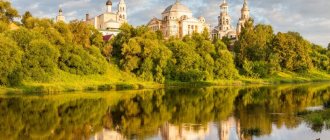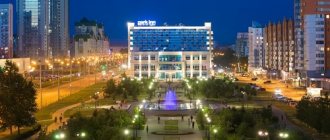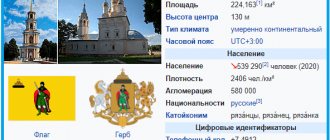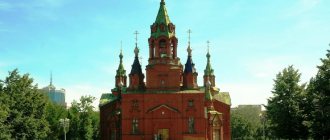There are probably many among us who have never heard of such a small but quite interesting city as Sterlitamak. "What area is this?" - they ask, usually a little surprised. We answer: this rather modest-sized settlement is located in the Republic of Bashkortostan (Russia).
What is this place famous for? What is so amazing about it? And why should everyone visit it at the first opportunity? This article is ready to answer all these and many other questions that are most often asked about the city of Sterlitamak. What area? How much time? Is the climate different? What do the local population do and what are the features of the local nature? All this will be discussed below.
In general, I would like to immediately note that when discussing the city of Sterlitamak, what region or region it is, it is not entirely correct to ask. Why? The thing is that this locality belongs to another territorial unit called a republic.
Section 1. General information about the city
So, Sterlitamak (which region of Russia and whether it is permissible to ask such questions in principle was indicated above) is considered the second most populous administrative center of the Republic of Bashkortostan in the Russian Federation.
It should be noted that this is a fairly large mechanical engineering hub by modern standards, as well as one of the most important centers of polycentric agglomeration. Sterlitamak is also known to many for its developed chemical industry.
Purely geographically, the city of Sterlitamak, the area of influence of which on the economy of our country is actually difficult to underestimate, is located on the left bank of the river. Belaya, 121 km south of Ufa.
This settlement was founded quite a long time ago, back in 1766. The region of the city of Sterlitamak had the same name, but subsequently, in 1953, it was abolished.
Delving into history, you can find out that this settlement initially arose around the so-called Sterlitamak salt water pier, but it was given the official status of a city in 1781.
In the not so distant past, the city of Sterlitamak (which region it was before 1953 is indicated above) was the capital of the autonomous Bashkir Republic. A little later, the role of the most important city in the region was transferred to Ufa, as a result of which the population in the city decreased significantly. Today, more than 278 thousand people permanently live here.
The time difference with Moscow is 2 hours.
Story
Between the forest and the steppe, surrounded by handsome shihans - the ancient rift mountains Yurak-Tau, Kush-Tau, Shah-Tau and Tra-Tau, five fast light rivers meet together - Ashkadar, Olkhovka, Sterlya, Seleuk and Belaya, turning the flat Cis-Urals into a wonderful a fertile land, rich in timber, fish, animals, birds, and minerals.
Once upon a time, millions of years ago, the endless waters of the ancient ocean stretched here, which gave life to the present-day Middle Pribelye - the homeland of modern Sterlitamak.
Window to the past
The past does not go away, it remains with us. His breath is in bronze spears of the 1st millennium BC, in rings, helmets and swords found in ancient Sarmatian burial mounds; in objects of jewelry and military art of the Bronze and Iron Age; in the household utensils of our distant ancestors, who were the first to inhabit these generous lands.
His confident step is in the creaking of carts and the knocking of axes of exiles allocated to the command of the merchant Savva Tetyushev for the foundation at the confluence of the Ashkadar and the White Salt Wharf; in the stomping and neighing of the horses of Ashkadar Yam - the postal station connecting Meleuz and Ufa.
Its nervous pulse is in the battle cries of the rebels, together with the people's hero of the peasant war Salavat Yulaev, who joined the Pugachev movement, one of the epicenters of which was the Sterlitamak outskirts; in the rapid flight of the cavalry of Pugachev’s Colonel Karanay Muratov, who managed to recapture the besieged pier from Catherine’s government troops; in the smoke and flames of numerous fires, each time forcing the city of assigned peasants and “service people”, merchants and artisans, officials and clergy, exiles and revolutionaries to be reborn from the ashes.
His bitter memory lies in the tragic events of the civil war; in the crying of the women of Sterlitamak, seeing off their men to the fronts of the Great Patriotic War; in the hard round-the-clock work of rear workers at factories and factories evacuated from Odessa, Baku, Kharkov, who together with the whole country forged Victory; in the sorrow of those who never saw their fathers, brothers, husbands and sons back from the war; in the fates of hundreds of those repressed during the Stalin era.
Its glorious milestones are the birth of large industrial giants in chemistry, petrochemistry and mechanical engineering; in the emergence of new avenues and streets, public gardens and squares, schools and kindergartens, residential neighborhoods and palaces of culture.
Sterlitamak traces its history back to 1766 - it was then that the Sterlitamak pier arose, which became the ancestor of the future city. The first mention of it as a county town is associated with the Decree of Catherine II “On the establishment of the Ufa governorate and two regions, Ufa and Orenburg, and on the division of them into counties,” signed in 1781. Eight years later, the first wooden church was built here, another five years later the first plan of the city was adopted, and a year later the first wooden mosque was erected. There will be many things for the first time in the fate of Sterlitamak - the opening of a gymnasium, a state-owned pharmacy, a printing house, the demonstration of a silent film, the holding of a football match, the organization of a teachers' seminary, the publication of a newspaper, the creation of a professional theater, the appearance of electric lighting...
During the years of revolutionary transformations, the city more than once was in the hands of the White Guards and White Czechs, and was liberated by regular units of the Red Army; All-Bashkir congresses of Soviets and crowded party rallies were held there; from 1919 to 1922 it was the capital of the BASSR. Sterlitamak played a huge role in the formation of statehood of Bashkortostan.
Having lost nine thousand of his sons in the war against fascism, in the middle of the 20th century it experienced a rebirth: it became a city of great chemistry, and new lines appeared in the chronicle of its achievements - the first million tons of soda ash, the first current of the Sterlitamak thermal power plant, the first rubber, the first acetylene, first production of white carbon. And behind all this - the first trolleybus, the first automatic telephone exchange, the first sports complex...
As the giants of chemistry and petrochemistry grew and gained power, other problems that were previously in the shadows began to worsen - environmental ones.
This is where the ability of the peoples inhabiting this land to understand and protect nature, passed down from generation to generation, came in handy. In the late 70s, a “green” movement arose and began to rapidly develop in Sterlitamak; city authorities and environmental scientists, business managers and schoolchildren, doctors and students entered the fight to clean up the air and water basins from harmful emissions. Sterlitamak owes its current green appearance to thousands of its residents, whose enthusiasm and selfless work turned it into the silver city of Russia - clean, beautiful, cozy, surrounded by the greenery of numerous parks and squares.
Today the city is the pearl of the south of our republic, where, surrounded by a generous and rare beauty of nature, human hands give birth to new “miracles” - raising children, growing bread and building houses, laying roads and laying pipelines, reconstructing industrial enterprises and opening schools, universities, maternity hospitals houses, restoring old churches and building new ones...
This is how this uninterrupted relay of glorious human deeds has been going on for almost two and a half centuries, from which the fate of the city on Sterla is formed - from the distant year 1766, shrouded in beautiful legends, to the present day.
The history of the city, thanks to the intertwining of cultures and beliefs of the peoples inhabiting it - Bashkir, Russian, Tatar, Chuvash, Mordovian, Ukrainian, German, etc. - resembles a multi-colored Bashkir ornament. Sterlitamak remembers the Cathedral of the Kazan Mother of God, destroyed in the first years of Soviet power, and the cathedral stone mosque, and the prayer house of the Old Believers, and the execution of members of the Sterlitamak Revolutionary Committee, and much more that has become history.
Modern Sterlitamak has become a home for representatives of more than seventy nationalities. They are brought together by holidays and everyday life, which reflect the hopes of these people, the everyday work of their life together. The city is looking towards the future with the firm intention of providing decent living conditions for every Sterlitamak resident.
The most important dates in the history of the city of Sterlitamak
1735
- at the place where the Sterlya flows into Ashkadar, a postal station “Ashkadar postal pit” was organized.
1765
- according to the project of the merchant S. Tetyushev, a decision was made to build a salt pier, from which salt was supposed to be delivered to the Central regions of Russia. So the Ashkadar pit became the Ashkadar pier.
1766
- the pier was named Sterlitamak (“tamak” in Bashkir - mouth). This date is the founding date of the city.
1773-1775
- during the Peasant War under the leadership of E.I. Pugachev, the Sterlitamak pier became the center for the formation of punitive detachments of government troops.
1781
— By decree of Empress Catherine II, Sterlitamak becomes a district town.
1782
- the city’s coat of arms was approved: “In the upper part of the shield is the coat of arms of Ufa - a running marten in a silver field, a sign of such animals in abundance. At the bottom are three swimming silver geese in a blue field, as a sign of the great abundance of these birds.” Today's coat of arms of the city district is a restored ancient coat of arms, which is a shield with the image of three silver geese swimming through silver water in an azure field.
1794
- the first city plan approved by the emperor was adopted; The Cathedral of the Kazan Mother of God was built.
1796
— thanks to the efforts of the collegiate adviser S.Ya. Levashev, alcohol production began in the city.
1870
— the Duma and the Council were opened in the city, a printing house and a one-class private women's school appeared.
1906
— for the first time a silent French film was shown in the city.
1909
– the first bakery of S.G. Zhilkin opened its doors, where bread baking was put on an industrial basis.
1916
- A teacher's seminary opens in the city.
May 1917
— the newspaper “Worker and Soldier” began publishing, the organ of the city Council of Workers’ and Soldiers’ Deputies.
October 1, 1917
— the first kindergarten appeared in Sterlitamak.
March 23, 1919
— The decree of the All-Russian Central Executive Committee proclaimed the creation of the Autonomous Bashkir Socialist Republic.
1919
— the first professional Bashkir drama theater is being created in the city; The newspaper, magazine and book publishing house Bashgosizdat begins operating.
1919-1922
— Sterlitamak was the capital of the Autonomous Bashkir Socialist Republic.
1920
— the first telephone switch with 50 numbers appears in Sterlitamak.
1921
— a cinema has opened in the city.
December 10, 1922
– “Ilyich’s lamps” were lit for the first time in the homes of city residents. The republican newspaper “Power of Labor” wrote: “Sterlitamak has come to life beyond recognition.”
1924
— the local history museum begins its work. P.Kh. Mikhailov and G.V. Sklyarov devoted many years to its creation.
1926
— the Bashkir Pedagogical College was created.
1929
— a city newspaper is published with a circulation of 2.5 thousand copies.
1930
— The City Council approved a long-term development plan for Sterlitamak for the next 30 years until 1960. At this time, about 24 thousand residents lived in the city, and about 1.5 thousand workers worked at industrial enterprises.
1930
- Sterlitamak district is formed. Oil exploration begins on its territory.
1932
— an oil technical school opens; A radio appears in the homes of the townspeople.
October 1, 1934
– the Ufa-Sterlitamak-Ishimbayevo railway with a total length of 177 km came into operation.
1935
– a medical paramedic and midwifery school appears in the city.
1936
— regular bus service opens with Ufa, Orenburg and other settlements; The first sound film installation was installed.
1939
— the first session of the city Council of Workers' Deputies has opened.
1940
- a two-year teacher's institute was opened.
June-November 1941
– the machine-tool plant named after V.I. Lenin was evacuated from Odessa to Sterlitamak, an oil equipment repair plant was evacuated from Baku (), and a shoe factory was evacuated from Moscow.
June-December 1941
– the city sheltered over 5.5 thousand evacuated citizens from the front line, providing them with housing, food and work.
December 1942
— The Ishimbayskaya CHPP provided industrial current for the enterprises of Sterlitamak.
October 1943
– By decree of the Presidium of the Supreme Soviet of the USSR, for the exemplary fulfillment of state tasks, the machine-tool plant named after V.I. Lenin was awarded the highest award of the Motherland - the Order of Lenin.
December 25, 1943
— the soda plant produced the first tons of caustic soda.
March 11, 1944
– the foundry of the construction machinery plant under construction produced its first products.
1941-1945
– more than 16 thousand people left the city and the Sterlitamak region for the front, of which 9 thousand died.
1941-1945
- during the Great Patriotic War, 28 soldiers of the city and region were awarded the title of Hero of the Soviet Union for the courage and heroism shown in the fight against the fascist invaders.
February 1946
– the Russian Drama Theater was opened.
1952
— a cement plant was put into operation.
1955
— the educational and consulting center of the All-Union Correspondence Polytechnic Institute begins to operate in the city.
1956
- A slate factory appeared in the city.
September 30, 1957
— the first stage of the Sterlitamak Thermal Power Plant gave power.
1958
– The Teachers' Institute was transformed into the Sterlitamak State Pedagogical Institute.
1959
– the first secondary boarding school in Bashkortostan with 880 places was opened.
1960
— start of operation of a synthetic rubber plant; the first stage of the city automatic telephone exchange is put into operation; gasification of the city begins, the Salavat cinema is built.
February 1961
— the first stage of the trolleybus line began operating.
January 1962
— a new city planning project until 1980 was developed and approved.
1962
— on the basis of the UCP of the All-Union Correspondence Polytechnic Institute, an evening department of the general technical faculty of the Ufa Petroleum Institute is being created.
1966
- The Iskra cinema opens in Sterlitamak.
September 17, 1969
— by order of the management of the Council of Ministers of the Bashkir Autonomous Soviet Socialist Republic on the use of labor resources in the city, a bureau for employment and information of the population was created.
1974
— the city’s first sports complex began operating.
1979
— the city Palace of Pioneers opened its doors.
May 17, 1990
— a meteorite fell two kilometers southwest of the Sterlitamaksky state farm. A crater with a diameter of up to 15 and a depth of up to 9 meters was discovered at the scene. Meteorite No. 180 is named “Sterlitamak”.
April 1991
— the executive committee of the city council decided to create a city television broadcasting studio in Sterlitamak.
1991
— the first issue of the newspaper “Ashkadar” was published in the Bashkir language; a city philharmonic society is created.
October 1992
— TRC “Ekran” went on air with its first broadcasts.
February 6, 1992
— the official opening of the first automatic telephone exchange ATS-5 took place.
1993
– the Sterlitamak branch of the Bashkir State University began work.
October 1, 1994
— Postgraduate studies have opened at the Sterlitamak State Pedagogical Institute.
1995
— the physical culture and health complex of the joint-stock company "Caustic" was put into operation.
1996
– the Sterlitamak branch of the Academy of Sciences of the Republic of Bashkortostan was opened, with K.B. Sabitov becoming its director.
late 1997 – early 1998
— the first minibuses appeared in the city.
Based on the results of 1997, 2002, 2005
Sterlitamak three times took 2nd place in the All-Russian competition “The most comfortable city in Russia” (among cities with a population of one hundred thousand to a million people).
1999
— the cable television studio “Satelit” went live for the first time – a 10-hour broadcast of Youth Day.
May 4, 2000
— a bust of Marshal of the Soviet Union Zhukov was unveiled in the park named after G.K. Zhukov. Sculptor A.S. Pimenov.
September 7, 2001
- started work.
2003
– the Salavat cinema was opened after reconstruction.
2004
– The Sterlitamak Pedagogical Institute has been given the status of an Academy.
2006
— the city acquired the status of a municipal entity.
2007
- according to the results of the All-Russian competition for the title of the most comfortable city in Russia in 2006, Sterlitamak took first place and became the “golden city of Russia”.
2007
– a new maternity hospital has appeared in the city.
2008
– the four-star Vostok Hotel opened its doors.
May 2008
— The Alley of Veterans was opened in the Sovetsky microdistrict.
year 2009
– opening of the Institute of Pedagogy and Psychology and the Institute of Mathematics and Natural Sciences on the basis of the Sterlitamak Pedagogical Academy named after Zainab Biisheva.
Section 2. Where did this name come from?
As for the name of the city itself, it turns out that it did not appear by chance at all, as it might seem at first glance, but after the merger of two words: the name of the local river Sterli, which flows through the central part of the city, and the word “tamak”, which in the Bashkir language it means “mouth of a water source”, or “throat”.
Thus, it is not difficult to guess that if we undertake to translate the entire word into Russian, it turns out that the name Sterlitamak sounds like “the mouth of the Sterli River.” Quite a euphonious and very logical name.
Hymn
Among the great mountains and rivers, Under a bright star Among the wild expanses With a happy destiny, Fanned by the winds, Always young at heart, And you and I know for sure - This city is called
Chorus:
Sterlitamak - the city of love has kindled freedom in our hearts. You can love, you can dream! Only in your heart will you find the way And you will learn that you can do anything.
Forward through life with a song Let's color this city With the warmth of smiles together Let's melt the ice and cold And smile at every dawn With all your heart There is nothing more valuable than life, Wake up quickly!
Presented at a gala concert in honor of City Day in 2014.
Section 3. Features of the physical and geographical location
The city of Sterlitamak, what region it is and whether it exists at all, was indicated above, is located in the European part of the Russian Federation. To the east of it lie the Ural Mountains, and to the west is the endless and very picturesque East European Plain.
It should be noted that in the vicinity of the city there are the so-called shikhans, which are unique geological natural monuments. Near Mount Kushtau there are numerous children's health camps, holiday homes, ski resorts with slopes and lifts. And this automatically means that there is almost never a shortage of tourists here.
Initially, the city of Sterlitamak was created between the Ashkadar and Sterli rivers. This is where the Old Town is now located - the historical center of Sterlitamak. Subsequently, of course, like many other cities in the world, it was built up. The most active population growth was in the northern and western directions. To date, 5 road bridges and 1 railway bridge have already been built across the Sterlya River within the city.
People interested in our country often ask why this settlement did not develop in a southern, seemingly more logical direction. The thing is that its growth there is limited by the Olkhovka River, which is the left tributary of the Ashkadar.
Parks and monuments, streets
Merchants' houses on:
Karl Marx street
- Estate of merchant Kuznetsov
Address: st.
Karl Marx, 88 It is a monument of wooden architecture and stands out for its intricate carved script.
It is also called the Gaidar House, since in 1921 the headquarters of the communist battalion under the command of Arkady Gaidar was located here.
- House of the merchant Zvezdin
Address: st.
Karl Marx, 107 An old brick mansion built at the turn of the 19th-20th centuries by Mikhail Evseevich Zvezdin. There was a hardware store on the ground floor, and a merchant's family lived on the second floor.
Now the prosecutor's office is located here. It is an architectural monument.
- Patrikeev's house
Address: Karl Marx, 89
The house was built in 1893. Architectural monument.
After the revolution there was a library here. Today there is a military commandant's office.
Zemstvo Council
Address: st. Karl Marx, 103
The building was built in 1913-1914 for the district zemstvo government and forms a single architectural complex with the mansion of the city public bank, which is now occupied by the local history museum.
After the October Revolution, the building was called the Palace of Labor. Party conferences and congresses of Soviets were held here.
Mira Street
- Milovanov's House
Address: st.
Mira, 3 An architectural monument of the late 19th century. Nowadays there is a grocery store here.
- Usmanov's House
Address: st.
Mira, 53 The mansion was built at the beginning of the 20th century by Gaifulla Galliulovich Usmanov. The first floor was occupied by a textile store, on the second there was a hotel.
In 1917, the building was confiscated. During the Patriotic War, the Druzhba clothing factory was located here.
- Malyshev House
Address: st.
Mira, 60 Architectural monument of 1915. Now there is a computer center here.
- House of Evdokia Nikitina
Address: st.
Mira, 61 Mansion of the early 20th century. Modern use - stationery store.
Khalturin street
- Budaev's house
Address: st.
Khalturina, 17 Brick building built in 1907. It is an architectural monument.
Used as a residential building.
- Dokuchaev's House
Address: st.
Khalturina, 19 The date of construction of the mansion is 1910. Now there is a residential building here.
Section 4. The current image of the city
The city of Sterlitamak is currently a major center of republican subordination. Previously, it was the capital of the Bashkir Autonomous Republic, which was then moved to Ufa, located 120 km from the above-mentioned city.
Today's settlement is famous for its mechanical engineering, chemical industry, and large federal highways pass nearby.
Despite its modest size, the city has interesting places to visit. For example, amazingly beautiful mosques have been preserved in the old part of the city.
It should be noted that, starting from the seventies of the last century, a special scheme was introduced in Sterlitamak: all residents intensively green their city. As a result of such painstaking work, the current settlement surpasses even the million-plus city of Samara in terms of the number of birch trees.
The infrastructure here is very developed. Everywhere guests of the city can expect a variety of shops, boutiques, cafes, pubs, and restaurants. By the way, not everyone knows that in 2007 Sterlitamak was recognized as the most comfortable city in the Russian Federation.
Churches and Temples
Tatiana Church
Address: st. Khalturina, 119 Phone: , Opening hours: Mon-Sat 07:00-19:00, Sun 07:00-19:30
The temple was founded by Tatyana Dyakova in 1897. Nearby, in a two-story building, an almshouse named after the Fedorovs was built. The church was closed twice - in 1930 and in 1959.
In the 90s, the temple was returned to the Orthodox Church. Since 2002, the Tatyana Church has become the courtyard of the Mother of God-Tabynsky Convent.
In the temple there is an icon of the Mother of God of the Addition of Mind. In front of the icon they ask for help in teaching and raising children.
Nur al-Iman Mosque
Address: st. Mira, 9
The mosque took three years to build with funds from local organizations and entrepreneurs. In 2007, it officially opened. The name of the mosque is translated as “ray of light.”
The mosque can accommodate 800 people and is divided into two halls – men’s and women’s. The interior decoration is modest, only the floor is decorated with Uzbek carpets.
Due to the many windows, the building is bright and cozy. The minarets around the main dome of the mosque serve as observation platforms.
Cathedral of St. Nicholas the Wonderworker
Address: st. Kalinina, 52 Phone: 8 8211 50733 Opening hours: Mon-Sat 08:00-20:00 Sun 07:00-20:00
St. Nicholas Church was built not so long ago, in 1988. Before this, after the closure of the Tatyana Church, services were held in a house purchased by the Orthodox community, where the baptismal church at St. Nicholas Cathedral is now located.
Now the temple is a cathedral - part of the Annunciation Convent. The patronal feast of the temple - the day of remembrance of St. Nicholas the Wonderworker - is celebrated on December 19. On this day, after the service, there is a festive concert, tea drinking and akathist reading.
Section 5. Salt water pier - a unique place on the map of Russia
Sterlitamak owes its emergence to a certain merchant Savva Tetyushev, who proposed a project to build a pier to receive huge quantities of Iletsk salt brought here. The total weight of the supplied seasoning, according to the plans of the businessman at that time, could easily reach a million pounds; problems with loading and unloading would still not arise. For those who are curious about when exactly the events listed above took place, let’s say that Tetyushev’s project with the attached notes of the Orenburg governor was approved by decree of January 19, 1766. Quite a significant period of time, isn’t it?
The first caravan with Iletsk salt, which left the pier in the spring of 1767, was not at all the promised million pounds, but three times less. With the emergence of the pier, local salt carriers called it Ashkadar, and not Sterlitamak, as Tetyushev wanted.
Soon, multiple shortcomings of the chosen location were revealed. As a result of the inspections, at the proposal of the Chairman of the Salt Commission of the Russian Federation P. D. Eropkin, in 1769 a salt pier from the shallow river. Ashkadar was moved to its original location.
She again began to be near the Bugulchan tract on the river. White. Although they still continued to send barges with other cargo from the previous pier, the weight of which, by the way, significantly exceeded the amount of salt previously exported.
It turns out that the city of Sterlitamak was very important in the life of the region.
Section 6. Where to go first?
If you are lucky enough to find yourself in this locality, try to find time and go to the local history museum, where many truly unique exhibits are collected.
On weekends, the city usually hosts interesting performances by the Benefis theater studio. They are distinguished by quite creative solutions, excellent directorial work, and unique acting. This production will appeal to everyone, from children to experienced theatergoers.
By the way, in Sterlitamak there are not one, but three good theaters.
Section 7. Monument at the 5th verst of the Ufa Highway
It is also worth seeing a very revered in the city and rather unique monument at the 5th verst of the Ufa Highway, which was built in memory of the executed members of the Revolutionary Committee and the Council of People's Commissars, killed by the White Czechs. This very tragic event occurred on the night of September 27-28 in 1918, exactly at the place where today’s monument is erected.
During the USSR, a wooden monument was initially placed here, then in the 60s a stone obelisk was built. Now this memorial is located in the very center of Sterlitamak on Lenin Avenue.
Needless to say, on holidays local residents always come here and lay flowers.
Flag
The flag of Sterlitamak is made in the form of a rectangular azure cloth. The aspect ratio is 2:3. It reproduces the main elements of the coat of arms - three swimming geese. It consists of three horizontal stripes. The top and bottom are blue, the middle is white, with a width of 7/10, 1/5, and 1/10 of the same panel size, respectively.
The flag was adopted on November 1, 2006 and entered into the State Heraldic Register of the Russian Federation under No. 3242.
Section 8. The city and its surroundings
There are many parks and squares in Sterlitamak, the largest of which is Victory Park. Next to the Palace of Culture there is a park named after. Marshal Zhukov, where there is a monument with the names of all the heroes, former residents of the city who died in the Second World War. You can also visit the park named after. Yu. Gagarin.
Note that the bulk of tourists come here purely for rafting on the Belaya River. During the warm season there are also many people who like hiking and spending time in the fresh air.
An interesting place in Sterlitamak is the airport, located in the southwest, 7 kilometers from the city limits. At this time it is closed and is not used for its intended purpose. But even being practically abandoned, it enjoys steady popularity among eco-tourists. It is also loved by fans of extreme sports who ride skateboards, rollerblades and special bicycles here.
However, you need to be careful here, since the territory is guarded and penetration there is not particularly legal.
Attractions in the surrounding area
Sterlitamak shihans
How to get there: from Sterlitamak on foot or by car
Cone-shaped single mountains stretch along the right bank of the Belaya River for 20 km. They are ancient coral reefs of the Ural paleoocean. Their age is 260 million years.
There is a beautiful Bashkir legend about the origin of the Shihans. As if the young proud hero was planning to win the love of the daughter of the mighty Urals. But the girl did not like him, she ran away from him. The hero indignantly gave chase, caught up with the fugitive and swung his whip. The Ural father, saving his daughter, turned her into a river. The guy sent a fast falcon after the beauty, but the falcon could not catch up with the girl and fell to the ground, turning into Kushtau - a bird-mountain. The hero also lost his horse, which became Mount Tratau. Having lost his last strength, the young man tore his heart out of his chest and threw it to his beloved, but the girl-river only ran around the Yuraktau heart-mountain and carried its waters further. But the hero remained in the steppe, turning into Shakhtau - the Tsar Mountain.
On the site of Shakhtau there is now a quarry. There is almost nothing left of the mountain. The public has so far managed to defend the rest of the mountains.
Yuraktau
Coordinates: 53.7409, 56.0975
An interesting historical event took place near the farthest shikhan of Yuraktau. At the beginning of the 18th century, there was a ten-day battle here between a detachment of rebel Bashkirs and the tsarist soldiers. A detachment of regular troops was defeated.
At the foot of the mountain there are springs, including sulfur springs, Lake Moksha.
Section 9. Nature of Lake Tugarsalgan
The reservoir is located at the very foot of the Tratau Shikhan. There is an island on Tugarsalganu, although it used to be a peninsula. Once upon a time, valuable endemic plants grew here, which at the moment, unfortunately, have been almost completely destroyed due to thoughtless human activity.
It is nice to note that at least something is being done to preserve the nature of this region. Thus, since 1965, Lake Tugarsalgan and its surroundings (about 100 hectares in total) are officially considered a natural monument.
From a geological point of view, Tugarsalgan is one of the deepest lakes of karst origin in Bashkortostan, its greatest depth in some places is 27 m. The lake is fed by spring waters. Its length is 395 m and its width is 260 m.
So, this article answered all the questions posed about the city of Sterlitamak: what area, where it is located geographically, a little history of its origin, a list of features and a list of the most interesting places to visit. All you have to do is try to feel its atmosphere.
Stelitamak museums and theaters
The cultural life of Sterlitamak is also diverse - in its museums and theater institutions you can see a lot of interesting, educational and beautiful things.
Stone Museum
- Address: Ishimbaysky district, Shakhtau-1 quarry.
In the 80s In the 20th century, the surroundings of Sterlitamak became the site of geological research: the Shakhtau quarry of the Early Permian period was discovered here. Ivan Skuin, a miner working in a quarry, became the initiator and inspirer of the Stone Museum, which today bears his name.
The museum opened its doors in 1985 and is still a popular tourist attraction. Among its more than 3,000 exhibits, it displays interesting fossils discovered during quarry exploration: limestone and faunal remains that are approximately 300 million years old.
The attraction is constantly visited by organized groups of schoolchildren and students, excursions are held free of charge, the costs of maintaining the exposition are now covered by the commercial organizations "Raw Materials".
Sterlitamak Art Gallery
- Address: Kommunisticheskaya st., 84.
The center of fine arts and artistic culture of the city of Sterlitamak is a branch of the Bashkir Museum of Fine Arts, which has been operating here since 1997. The gallery is a place where works of famous artists of the region from Ufa, Sterlitamak and other cities are exhibited.
Particular attention is paid here to contemporary art. Exhibitions of paintings from the collections of the main museum are often held. The gallery carries out educational work; creative evenings, lectures, master classes and other entertaining and educational events are held on its territory, which you can watch on your own.
Russian Drama Theater
- Address: st. Khudayberdina, 18.
One of the main theaters of the city, existing since 1946. Founded by a resolution of the Council of People's Commissars of the Bashkir Autonomous Soviet Socialist Republic on the basis of the Beloretsk Drama Theater that toured in the city. The most outstanding leader in the history of the institution is considered to be Konstantin Khristoforovich Shakhbazidi, who in August 1946 replaced the first director I.I. Chernyshevsky-Tolkachev.
Today the repertoire of the cultural attraction includes more than 600 performances. Much attention is paid to the classics. Performances and performances are based on famous plays and classic works of Russian and world literature. The works of Tolstoy, Ostrovsky, Chekhov, Schiller, Shakespeare, Gorky, Gogol, Bulgakov, Camus and many other authors are embodied on stage.
Sterlitamak State Theater and Concert Association
- Address: ave. Lenina, 30V.
Includes the second most important in the city, the Sterlitamak Bashkir Drama Theater, as well as the State Philharmonic Society. This drama theater has been operating since 1991. It stands out because it has a national flavor; in the life of the establishment, much attention is paid to local authors and stories.
The date of its opening is considered to be the premiere of the play “Heirs” based on the play by local author Dulat Isabekov. There are many honored and people's artists of Bashkortostan in the troupe. The team has become a laureate of many competitions, the artists successfully tour with their productions throughout the country.
The State Philharmonic, located in a separate building, employs five groups. The most famous are the Dance Theater and the pop and folk ensemble Sabri. An important event in the cultural life of the city are performances by the local folk orchestra. A literary and musical lecture hall operates on the basis of the Philharmonic.










